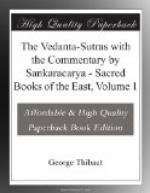nor are told by Scripture that the welfare of man
depends on those matters in any way; nor have we the
right to assume such a thing; because we conclude
from the introductory and concluding clauses that the
passages about the creation and the like form only
subordinate members of passages treating of Brahman.
That all the passages setting forth the creation and
so on subserve the purpose of teaching Brahman, Scripture
itself declares; compare Ch. Up. VI, 8, 4,
’As food too is an offshoot, seek after its
root,
viz. water. And as water too is an
offshoot, seek after its root,
viz. fire.
And as fire too is an offshoot, seek after its root,
viz. the True.’ We, moreover, understand
that by means of comparisons such as that of the clay
(Ch. Up. VI, 1, 4) the creation is described
merely for the purpose of teaching us that the effect
is not really different from the cause. Analogously
it is said by those who know the sacred tradition,
’If creation is represented by means of (the
similes of) clay, iron, sparks, and other things; that
is only a means for making it understood that (in
reality) there is no difference whatever’ (Gau/d/ap.
Ka. III, 15).—On the other hand, Scripture
expressly states the fruits connected with the knowledge
of Brahman, ’He who knows Brahman obtains the
highest’ (Taitt. Up. II, 1); ’He
who knows the Self overcomes grief’ (Ch.
Up. VII, 1, 3); ’A man who knows him passes
over death’ (
Sve. Up. III, 8).
That fruit is, moreover, apprehended by intuition
(pratyaksha), for as soon as, by means of the doctrine,
‘That art thou,’ a man has arrived at the
knowledge that the Self is non-transmigrating, its
transmigrating nature vanishes for him.
It remains to dispose of the assertion that passages
such as ’Non-being this was in the beginning’
contain conflicting statements about the nature of
the cause. This is done in the next Sutra.
15. On account of the connexion (with passages
treating of Brahman, the passages speaking of the
Non-being do not intimate absolute Non-existence).
The passage ‘Non-being indeed was this in the
beginning’ (Taitt. Up. II, 7) does
not declare that the cause of the world is the absolutely
Non-existent which is devoid of all Selfhood.
For in the preceding sections of the Upanishad Brahman
is distinctly denied to be the Non-existing, and is
defined to be that which is (’He who knows the
Brahman as non-existing becomes himself non-existing.
He who knows the Brahman as existing him we know himself
as existing’); it is further, by means of the
series of sheaths, viz. the sheath of food, &c.,
represented as the inner Self of everything. This
same Brahman is again referred to in the clause, ‘He
wished, may I be many;’ is declared to have
originated the entire creation; and is finally referred
to in the clause, ‘Therefore the wise call it
the true.’ Thereupon the text goes on to
say, with reference to what has all along been the




